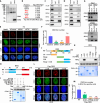CK2-dependent degradation of CBX3 dictates replication fork stalling and PARP inhibitor sensitivity
- PMID: 38781342
- PMCID: PMC11114232
- DOI: 10.1126/sciadv.adk8908
CK2-dependent degradation of CBX3 dictates replication fork stalling and PARP inhibitor sensitivity
Abstract
DNA replication is a vulnerable cellular process, and its deregulation leads to genomic instability. Here, we demonstrate that chromobox protein homolog 3 (CBX3) binds replication protein A 32-kDa subunit (RPA2) and regulates RPA2 retention at stalled replication forks. CBX3 is recruited to stalled replication forks by RPA2 and inhibits ring finger and WD repeat domain 3 (RFWD3)-facilitated replication restart. Phosphorylation of CBX3 at serine-95 by casein kinase 2 (CK2) kinase augments cadherin 1 (CDH1)-mediated CBX3 degradation and RPA2 dynamics at stalled replication forks, which permits replication fork restart. Increased expression of CBX3 due to gene amplification or CK2 inhibitor treatment sensitizes prostate cancer cells to poly(ADP-ribose) polymerase (PARP) inhibitors while inducing replication stress and DNA damage. Our work reveals CBX3 as a key regulator of RPA2 function and DNA replication, suggesting that CBX3 could serve as an indicator for targeted therapy of cancer using PARP inhibitors.
Figures







References
-
- Burrell R. A., McClelland S. E., Endesfelder D., Groth P., Weller M. C., Shaikh N., Domingo E., Kanu N., Dewhurst S. M., Gronroos E., Chew S. K., Rowan A. J., Schenk A., Sheffer M., Howell M., Kschischo M., Behrens A., Helleday T., Bartek J., Tomlinson I. P., Swanton C., Replication stress links structural and numerical cancer chromosomal instability. Nature 494, 492–496 (2013). - PMC - PubMed
-
- Petermann E., Helleday T., Pathways of mammalian replication fork restart. Nat. Rev. Mol. Cell Biol. 11, 683–687 (2010). - PubMed
MeSH terms
Substances
LinkOut - more resources
Full Text Sources
Other Literature Sources
Miscellaneous

